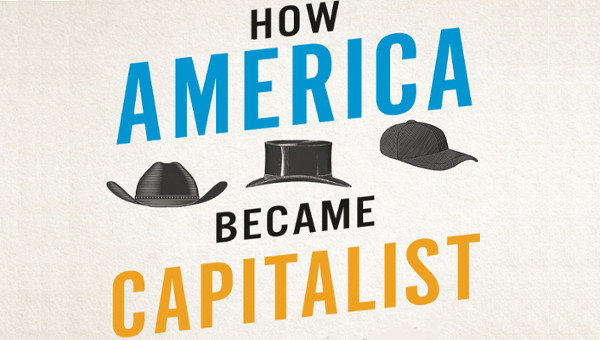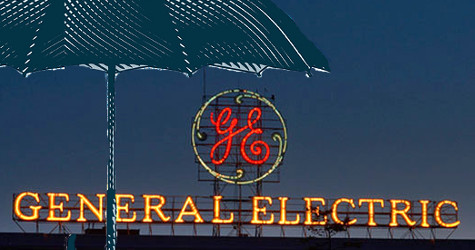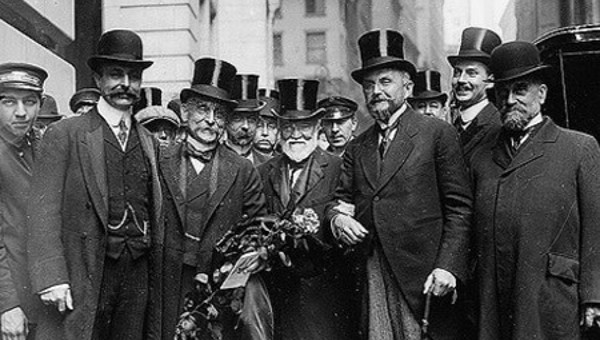Popular Radicalism in the 1930s
The History of the Workers’ Unemployment Insurance Bill
At a time when unemployment is skyrocketing in the US and millions of out-of-work Americans have been abandoned by the federal government, it may be of interest to consider how an earlier generation responded to an even greater crisis, the Great Depression (1929-1936). In particular, we might draw inspiration from the remarkable story of the now-forgotten Workers’ Unemployment Insurance Bill that was introduced in Congress in 1934, 1935, and 1936.
Despite essentially no press coverage and extreme hostility from the business community and the Franklin Roosevelt (FDR) administration, a popular movement developed in support of this bill that had been written by the Communist Party. The mass pressure that was brought to bear on Congress secured a stunning victory in the spring of 1935, when the bill became the first unemployment insurance plan in US history to be recommended by a congressional committee (the House Labor Committee). It was defeated in the House – by a vote of 204 to 52 – but the widespread support for the bill was likely a factor in the easy passage later in 1935 of the relatively conservative Social Security Act, which laid the foundation for the American welfare state.
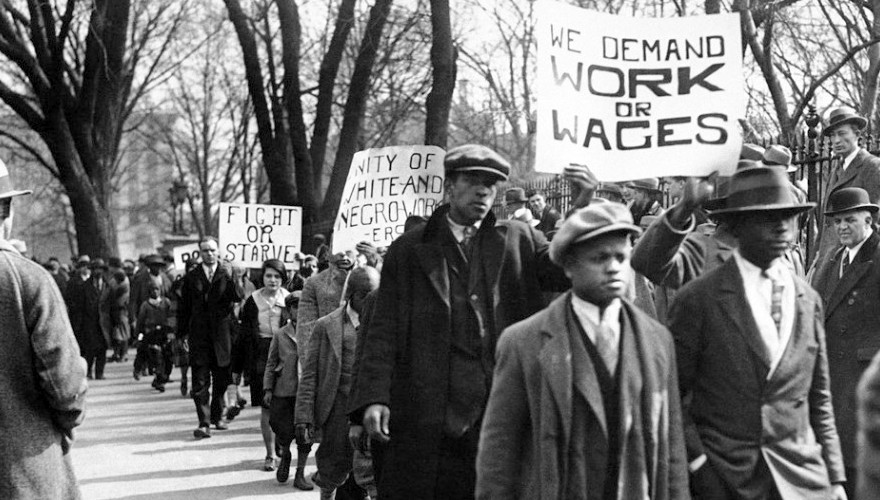
Aside from its direct legislative importance, the Workers’ Bill is of interest in that it shows just how left-wing vast swathes of the US population were in the 1930s and can become when a political force emerges to articulate their grievances. This bill, which was far more radical than provisions in the Soviet Union for social insurance, was endorsed by over 3,500 local unions (and the regular conventions of several International unions and state bodies of the American Federation of Labor), as well as practically every unemployed organization in the country, fraternal lodges, governmental bodies in over seventy cities and counties, and groups representing veterans, farmers, Blacks, women, the youth, and churches. In the West, the South, the Midwest, and the East, millions of citizens signed petitions and postcards in support of it. And this was all despite the active hostility of every sector of society with substantial resources.
Liberal Consensus of Historiography
It is puzzling, then, that historians have almost entirely overlooked the Workers’ Bill. For instance, in his book Voices of Protest: Huey Long, Father Coughlin, and the Great Depression, Alan Brinkley doesn’t devote a single sentence to it. Neither does Robert McElvaine in his standard history The Great Depression: America, 1929–1941. David Kennedy devotes half a sentence to it in volume one of his Oxford history of the Depression and World War II, Freedom from Fear: The American People in Depression and War. Instead, the less sophisticated and less radical Townsend Plan for old-age insurance, which was proposed around the same time and was widely publicized in the press, tends to monopolize historians’ attention (only to be ridiculed). The neglect of the Workers’ Bill lends credence to a still-dominant interpretation of the American citizenry during the Depression and throughout its history, viz. as being relatively centrist, “individualistic,” and conservative, especially in comparison with the historically more “socialist” populations of Western Europe.
Brinkley sums up this strain of thinking derived from the postwar “liberal consensus” school of historiography, which still influences pundits, politicians, and academics:
“The failure of more radical political movements to take root in the 1930s reflected, in part, the absence of a serious radical tradition in American political culture. The rhetoric of class conflict echoed only weakly among men and women steeped in the dominant themes of their nation’s history; and leaders relying upon that rhetoric faced grave, perhaps insuperable difficulties in attempting to create political coalitions…”
This is a simplistic interpretation. For one thing, there is a serious radical tradition in American political culture, as embodied, for example, in the Populist movement of the 1890s and the Socialist Party and IWW of the early twentieth century. But even insofar as a case can be made that “the rhetoric of class conflict echoe[s]…weakly,” it is plausible to understand this fact as simply a reflection of the violent repression of class-based movements and parties in American history. When they have a chance to get their message out, they attract substantial support – precisely to the extent that they can get their message out. There is no need to invoke deep cultural traditions of individualism or a lack of popular understanding of class. One need only adduce the skewed distribution of resources, which prevents leftists from being heard.
In this article I’ll tell the story of the Workers’ Unemployment Insurance Bill, both to fill a gap in our historical knowledge and because it resonates in our own time of troubles and struggles.
The Workers’ Unemployment Insurance Bill of 1930
As soon as the Communist Party had unveiled its proposed Workers’ Unemployment Insurance Bill in the summer of 1930, as the Depression was just beginning, it garnered extensive support among large numbers of the unemployed. The reason isn’t hard to fathom: it envisioned an incredibly generous system of insurance. In the form it would eventually assume, it provided for unemployment insurance for workers and farmers (regardless of age, sex, or race) that was to be equal to average local wages but no less than $10 per week plus $3 for each dependent; people compelled to work part-time (because of inability to find full-time jobs) were to receive the difference between their earnings and the average local full-time wages; commissions directly elected by members of workers’ and farmers’ organizations were to administer the system; social insurance would be given to the sick and elderly, and maternity benefits would be paid eight weeks before and eight weeks after birth; and the system would be financed by unappropriated funds in the Treasury and by taxes on inheritances, gifts, and individual and corporate incomes above $5,000 a year. Later iterations of the bill went into greater detail on how the system would be financed and managed.
Had the Workers’ Bill ever been enacted, it would have revolutionized the American political economy. It was a much more authentically socialist plan than existed in the Soviet Union at the time, where only 35 per cent of the customary wage was paid to those not working, and that for only a limited time (unlike with the Workers’ Bill). Nor was the Soviet insurance system administered democratically by workers’ representatives.
By 1934, when the plan had become widely enough known to be critically examined by economists and other intellectuals, it was frequently criticized for incentivizing malingering. Defenders of the bill – and by then it was advocated by many left-wing economists, teachers, social workers, lawyers, engineers, and other professionals – replied that this supposed flaw was in fact a strength. By withdrawing workers from the labor market, it would force wage rates to rise until they at least equaled unemployment benefits. “The benefits to the unemployed,” economist Paul Douglas noted, “could thus be used as a lever to compel industry to pay a living wage to those who were employed.” It was the abolition of poverty and economic insecurity that was envisioned – by a frontal attack on such fundamentals of capitalism as the private appropriation of wealth, determination of wages by the market, and maintenance of an insecure army of the unemployed.
The Unemployed Councils were at the forefront of agitation for the proposed bill, but it was also publicized through other auxiliary organizations of the Communist Party, in addition to activists in unions. As mass demonstrations for unemployment relief became more frequent – daily “hunger marches” in cities across the country, occupations of state legislative chambers, marches on city halls, “eviction riots” – the demand for unemployment insurance echoed louder and farther every month. From Alaska to Texas, requests for petitions flooded into the New York office of the National Campaign Committee for Unemployment Insurance. United front conferences of Socialist and Communist workers’ organizations took place from New York City to Gary, Indiana, and beyond. In February 1931 delegates presented the Workers’ Bill and its hundreds of thousands of signatures to Congress, which ignored them.
So, activists continued drumming up support for the next few years. Hunger marchers in many states demanded that legislatures pass versions of the bill; two national hunger marches the Communist Party organized in December 1931 and 1932 gave the bill further publicity; delegates periodically presented more petitions to Congress, and campaigns were organized to mail postcards to legislators. Despite the fervent hostility and smear campaigns of the national American Federation of Labor (AFL) leadership, several thousand local unions eventually endorsed the bill, especially after it had been sponsored, in 1934, by Representative Ernest Lundeen of the Minnesota Farmer-Labor Party. Its newfound national prominence in that year gave the movement greater momentum, and a new organization was founded to lend the bill intellectual respectability: the Inter-Professional Association for Social Insurance (IPA). Within a year the IPA had dozens of chapters and organizing committees around the country, as distinguished academics like Mary Van Kleeck of the Russell Sage Foundation proselytized for the bill in the press and before Congress.
Meanwhile, conferences of unemployed groups grew ever larger and more ambitious. For instance, in Chicago in September 1934, hundreds of delegates from such groups as the National Unemployed Leagues, the Illinois Workers Alliance, the Eastern Federation of Unemployed and Emergency Workers Union, and the Wisconsin Federation of Unemployed Leagues – in the aggregate claiming a membership of 750,000 – endorsed the Lundeen Bill (as it was now called) and made increasingly elaborate plans to pressure Congress for its passage.
Congress took essentially no action on the bill in 1934, so Lundeen reintroduced it in January 1935. This would become the year of the “Second New Deal,” when the Roosevelt administration turned left in response to massive discontent and disillusionment with its policies. Senator Huey Long had become a hero to millions by denouncing the wealthy and proposing his Share Our Wealth program, an implicit criticism of the New Deal’s conservatism. The “radio priest” Father Charles Coughlin had acquired heroic stature among yet more millions by constantly “talking about a living wage, about profits for the farmer, about government-protected labor unions,” as one journalist put it. “He insists that human rights be placed above property rights. He emphasizes the ‘wickedness’ of ‘private financialism and production for profit.’”
The tens of millions of people who flocked to the banners of Huey Long and Father Coughlin – not to mention the Communist Workers’ Bill (or Lundeen Bill) – put the lie to any interpretation of the American people as being irremediably conservative/centrist or wedded to capitalism. During the Great Depression, arguably a majority wanted the US to become, in effect, a radical social democracy, or a socialist democracy.
The Bill Goes to Congress
The hearings in 1935 that were held before the Labor subcommittee on the Lundeen Bill are a remarkable historical document, “probably the most unique document ever to appear in the Congressional record,” at least according to the executive secretary of the IPA. Eighty witnesses testified: industrial workers, farmers, veterans, professional workers, African-Americans, women, the foreign-born, and youth. “Probably never in American history,” an editor of the Nation wrote, “have the underprivileged had a better opportunity to present their case before Congress.” The aggregate of the testimonies amounted to a systematic indictment of American capitalism and the New Deal, and an impassioned defense of the radical alternative under consideration.
From the representative of the American Youth Congress, which encompassed over two million people, to the representative of the United Council of Working-Class Women, which had 10,000 members, each testimony fleshed out the eminently class-conscious point of view of the people back home who had “gather[ed] up nickels and pennies which they [could] poorly spare” in order to send someone to plead their case before Congress. At the same time, the Social Security Act – known then as the Wagner-Lewis Bill, since it hadn’t been passed yet – was criticized as a cruel sham, “a proposal to set up little privileged groups in the sea of misery who would be content to sit on their small islands and watch the others drown” (to quote a professor at Smith College). What most Americans wanted, witnesses insisted, was the more universal plan embodied in the Lundeen Bill.
Interestingly, most congressmen on the subcommittee were sympathetic to this point of view. For instance, at one point the chairman, Matthew Dunn, interrupted a witness who was observing that all the members of Congress he had talked to had received far fewer cards and letters in support of the famous Townsend Plan – which the press was continually publicizing – than in support of the more radical Lundeen Bill. “I want to substantiate the statement you just made about the Townsend bill and about this bill,” Dunn said. “May I say that I do not believe I have received over a half dozen letters to support the Townsend bill… [But] I have received many letters and cards from all over the country asking me to give my utmost support in behalf of the Lundeen bill, H.R. 2827.”
Many of the letters congressmen received were probably in the vein of this one that was sent to Lundeen in the spring of 1935, when Congress was considering the three competing bills that have already been mentioned (the Wagner-Lewis, the Townsend, and the Lundeen):
“The reason I am writing you is, that we Farmers [and] Industrial workers feel that you are the only Congressman and Representative that is working for our interest. We have analyzed the Wagner-Lewis Bill [and] also [the] Townsend Bill. But the Lundeen H.R. (2827) is the only bill that means anything for our class… The people all over the country are [waking] up to the facts that the two old Political Parties are owned soul, mind [and] body by the Capitalist Class.”
As stated above, while the House Labor Committee recommended the Lundeen Bill, it was – inevitably – defeated in the House. Being opposed by all the dominant interests in the country, it never had a chance of passage. But as far as its advocates were concerned, the fight was not over. Throughout the spring and summer of 1935 the flood of endorsements did not let up. The first national convention of rank-and-file social workers endorsed it in February; the Progressive Miners of America followed, along with scores of local unions and such ethnic societies as the Italian-American Democratic Organization of New York (with 235,000 members) and the Slovak-American Political Federation of Youngstown, Ohio. Almost identical state versions of H.R. 2827 were, or already had been, introduced in the legislatures of California, Oregon, Utah, Wisconsin, Ohio, Pennsylvania, Massachusetts, and other states. Conferences of unions and fraternal organizations were called in a number of states to plan further campaigns for the Workers’ Bill.
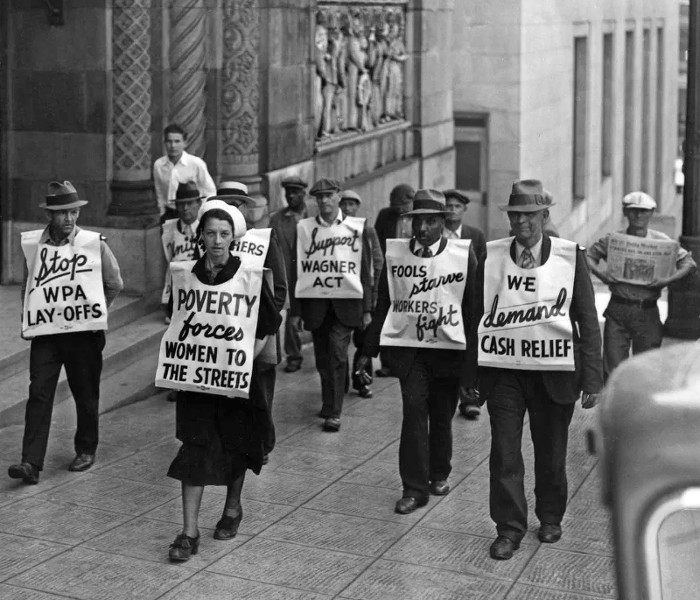
In January 1936, Representative Lundeen introduced the bill yet again, this time joined by Republican Senator Lynn Frazier of North Dakota. It didn’t even make it out of committee that year, and was never introduced again.
Despite its failure, the Workers’ Unemployment Insurance Bill was a significant episode in the 1930s that certainly hasn’t deserved to be written out of history. Both substantively and in its popularity, a case can be made that it was more significant than the Social Security Act and the Townsend Plan, its two main competitors.
Speaking to the Toiling People
As a coda to this forgotten story, which reinforces the lesson that most working-class Americans were and are quite left-wing in many of their values and beliefs, we might consider an unusual incident that occurred in March 1936. Earl Browder, head of the American Communist party, was, bizarrely, invited by CBS to speak for fifteen minutes (at 10:45 p.m.) on a national radio broadcast.
He seized the opportunity for this national spotlight and appealed to “the majority of the toiling people” to establish a national Farmer-Labor Party that would be affiliated with the Communist Party, though it “would not yet take up the full program of socialism, for which many are not yet prepared.” He even declared that Communists’ ultimate aim was to remake the US “along the lines of the highly successful Soviet Union”: once they had the support of a majority of Americans, he said, “we will put that program into effect with the same firmness, the same determination, with which Washington and the founding fathers carried through the revolution that established our country, with the same thoroughness with which Lincoln abolished chattel slavery.”
According to both CBS and the Daily Worker, reactions to Browder’s talk were almost uniformly positive. CBS immediately received several hundred responses praising the speech, and the Daily Worker, whose New York address Browder had mentioned on the air, received thousands of letters. The following are representative:
Chattanooga, Tennessee: “If you could have listened to the people I know who listened to you, you would have learned that your speech did much to make them realize the importance of forming a Farmer-Labor Party. I am sure that the 15 minutes into which you put so much that is vitally important to the American people was time used to great advantage. Many people are thanking you, I know.”
Evanston, Illinois: “Just listened to your speech tonight and I think it was the truest talk I ever heard on the radio. Mr. Browder, would it not be a good thing if you would have an opportunity to talk to the people of the U.S.A. at least once a week, for 30 to 60 minutes? Let’s hear from you some more, Mr. Browder.”
Sparkes, Nebraska: “Would you send me 50 copies of your speech over the radio last night? I would like to give them to some of my neighbors who are all farmers.”
Arena, New York: “Although I am a young Republican (but good American citizen) I enjoyed listening to your radio speech last evening. I believe you told the truth in a convincing manner and I failed to see where you said anything dangerous to the welfare of the American people.”
Julesburg, Colorado: “Heard your talk… It was great. Would like a copy of same, also other dope on your party. It is due time we take a hand in things or there will be no United States left in a few more years. Will be looking forward for this dope and also your address.”
In general, the main themes of the letters were questions like, “Where can I learn more about the Communist Party?” “How can I join your Party?” and “Where is your nearest headquarters?” Some people sent money in the hope that it would facilitate more broadcasts. The editors of the Daily Worker plaintively asked their readers, “Isn’t it time we overhauled our old horse-and-buggy methods of recruiting? While we are recruiting by ones and twos, aren’t we overlooking hundreds?” Again, one can only imagine how many millions of people in far-flung regions would have been quickly radicalized had Browder or other Communist leaders been permitted the national radio audience that Huey Long and Father Coughlin were.
But such is the history of workers and marginalized groups in the US: elite efforts to suppress the political agenda and the voices of the downtrodden have all too often succeeded, thereby wiping out the memory of popular struggles. If we can resurrect such stories as that of the Workers’ Bill, they may prove of use in our own age of crisis, as new struggles against authoritarianism begin. •


